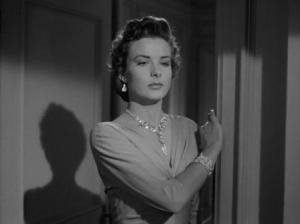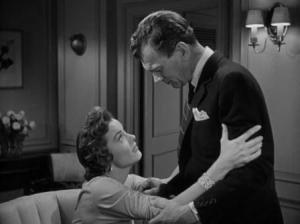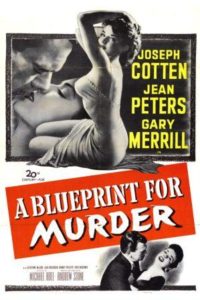He kissed her into the most sacred confession a woman can make!
Joseph Cotten is an actor who works very well in almost any setting, but yet strangely seems uniquely unable to be the go-to actor for any particular genre. In the little known 1953 film A Blueprint for Murder he is Cam Cameron, uncle for his deceased brother’s children Polly and Doug. As the picture opens his niece Polly passes away from a curious illness which at least initially has the doctors baffled.
It is only after the family lawyer Fred (played here by an underutilized Gary Merrill) points out that not only did his brother pass away under somewhat similar circumstances, but also that should the second child also die stepmother Lynn (Jean Peters) will stand to inherit a pretty sizable chunk of spending money.
 This gets old Cam thinking that perhaps Lynn is an evil murderess, and the straightforward approach of the film does nothing to put much doubt in your mind that this is completely logical thinking. As pieces begin to come together, we learn via the autopsy that Polly was in fact poisoned by strychnine; to complicate matters a bit further Lynn was in favor of immediate cremation of the child, which would have eliminated any evidence.
This gets old Cam thinking that perhaps Lynn is an evil murderess, and the straightforward approach of the film does nothing to put much doubt in your mind that this is completely logical thinking. As pieces begin to come together, we learn via the autopsy that Polly was in fact poisoned by strychnine; to complicate matters a bit further Lynn was in favor of immediate cremation of the child, which would have eliminated any evidence.
But then we have a bit of a red herring, as a similar autopsy of Cam’s deceased brother reveals nothing of the sort. This lack of continuity is either a lack of continuity or a stroke of genius, but we- the audience- are never let in on the joke either way. It is merely noted and then passed over without any further explanation. Seemingly having poising in the brother’s body as well would have helped the plot, but perhaps there was some attempt to cast doubt as to who the murderer really was.
 There is a piece partway through the film during which Lynn is at a hearing to determine whether there is enough evidence to send her to trial which is potentially critical. There it is noted that should Doug and Lynn die, the estate would go to Cam.
There is a piece partway through the film during which Lynn is at a hearing to determine whether there is enough evidence to send her to trial which is potentially critical. There it is noted that should Doug and Lynn die, the estate would go to Cam.
Now that got me thinking- or reinforced the thinking I already had, which was that perhaps Cam was the guilty party. Now that would have required the spin on the plot and his own internal narrative to be pure deception. Could it be a plot twist like Columbo episodes of old or all those Law & Order shows?
Let’s just say that isn’t likely as we proceed like a freight train towards the climax where the killer is ultimately revealed. Though the ending holds more than a bit of potential is comes off as rather a letdown in the final analysis. There are two amazing tells towards the end which lets any astute viewer know the end game. One is how the finale is shot by director Andrew Stone as the emotions that should have been on camera simply aren’t there. The other is the run time which is another trick learned from watching too many television crime dramas. It is extremely rare to have a huge twist with only minute of film left.
 Perhaps that is where the entertaining and enjoyable A Blueprint for Murder goes awry. We’ve simply seen this before and even period audiences would have been accustomed to it, given the influx of television shows at the time following a similar path. At only a 77 minute run time it is shorter than two complete episodes of any hour long drama today (though those same episodes would have been longer in earlier years, as commercials have increased at the expense of content over time).
Perhaps that is where the entertaining and enjoyable A Blueprint for Murder goes awry. We’ve simply seen this before and even period audiences would have been accustomed to it, given the influx of television shows at the time following a similar path. At only a 77 minute run time it is shorter than two complete episodes of any hour long drama today (though those same episodes would have been longer in earlier years, as commercials have increased at the expense of content over time).
Though a very good film, we are never really in any doubt that Lynn is the killer. (There, I said it!) We never have a viable suspect other than her, and outside of the one line (and my overly creative mind) Cam is never hinted at and a similar passing inquiry of Lynn’s housekeeper goes nowhere as well. There is enough suspense to keep you engaged, but not nearly enough to get you enthralled.
And as much as I did (and do) enjoy the film, it is a bit startling to see that there are three very distinct pieces to the film- though the lack of any subplots or additional suspects admittedly makes a more diverse result difficult to envision. The first third I will call the “Oh dear, I think this is murder” portion. The second piece is the “Insert Adam-12 episode here” portion, as it feels like that- little more or less. The final third is the “Did she or did she?” moment.
But for all the formulaic and clichéd approaches here, it is a good picture, mostly because of Joseph Cotten and Jean Peters. Cotten’s role is almost a light reprise of his role in Shadow of a Doubt and coupled with the surprisingly effective Jean Peters they almost single handedly drive the picture.
 In many cases the dynamic duo of Cotten and Peters overcome the simplistic direction and the straightforward plot. You want to believe that perhaps Cam is the killer in spite of what you see on screen. Likewise, you see the smug Lynn and know that she could have done it. Peters slips into the almost dual role of murderess and wealthy socialite with undue ease. Both are captivating here.
In many cases the dynamic duo of Cotten and Peters overcome the simplistic direction and the straightforward plot. You want to believe that perhaps Cam is the killer in spite of what you see on screen. Likewise, you see the smug Lynn and know that she could have done it. Peters slips into the almost dual role of murderess and wealthy socialite with undue ease. Both are captivating here.
Surely intended as part of a double feature given the short length, A Blueprint for Murder give a good showing in spite of weak production values and a simplistic plot. Don’t fixate on what a Hitchcock could have done with the material (especially that final scene) and enjoy this simple but enjoyable little film.
